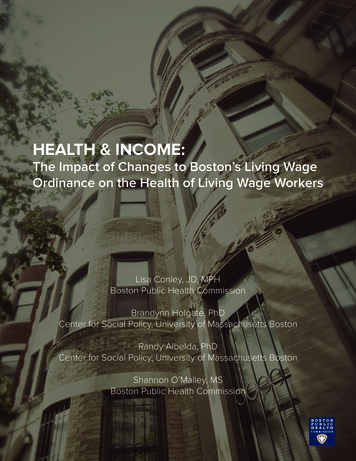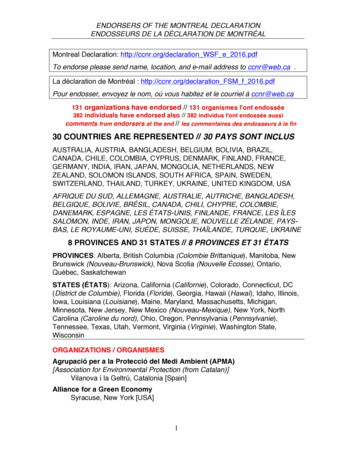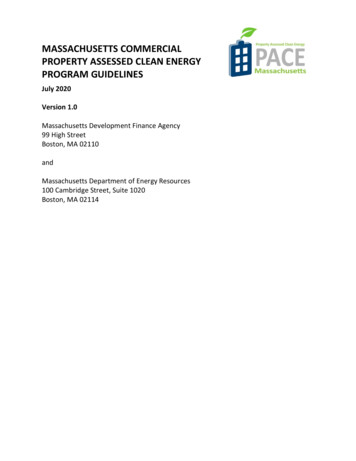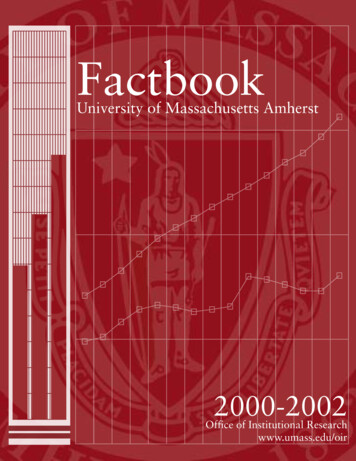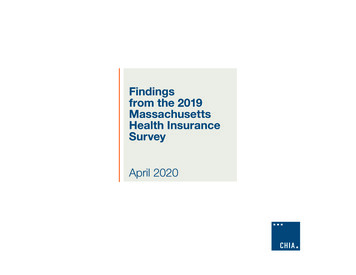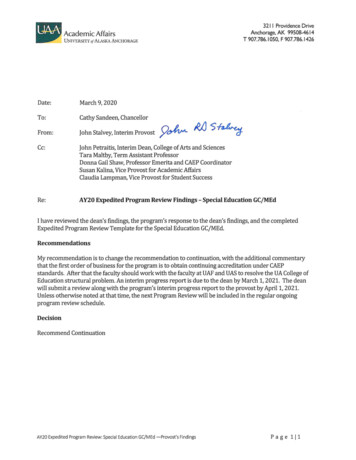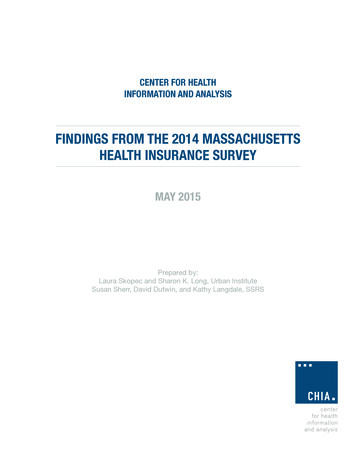
Transcription
CENTER FOR HEALTHINFORMATION AND ANALYSISFINDINGS FROM THE 2014 MASSACHUSETTSHEALTH INSURANCE SURVEYMAY 2015Prepared by:Laura Skopec and Sharon K. Long, Urban InstituteSusan Sherr, David Dutwin, and Kathy Langdale, SSRS
Table of ContentsExecutive Summary4Health Insurance Coverage and Uninsurance6Uninsurance6Characteristics of the Remaining Uninsured7Reasons for Being Uninsured7Types of Health Insurance Coverage9Offers of Employer-Sponsored Insurance10Transitions in Health Insurance Coverage10Health Care Access and Use14Usual Source of Care and Health Care Visits14Emergency Department Use16Difficulties Accessing Health Care21Health Care Affordability24Out-of-Pocket Spending and Difficulty Paying Medical Bills24Unmet Need for Health Care Due to Cost25Approaches to Lower Health Care Costs28Summary and Conclusions31About the MHIS32Notes32
Executive SummaryIntroductionAs part of the Center for Health Information andAnalysis’ (CHIA’s) Continuing Program of Study onInsurance Coverage, Underinsurance and Uninsurance,the Massachusetts Health Insurance Survey (MHIS)provides information on health insurance coverage,health care access and use, and perceived health careaffordability for Massachusetts residents.1 The MHISis a tool used by CHIA, legislators, policymakers,employers, insurers and other stakeholders to trackand monitor the experiences of Massachusettsresidents in obtaining timely and affordable health care.In 2014, the MHIS methodology was modified toprovide a better understanding of health insurancecoverage in the Commonwealth.2 Therefore, the2014 MHIS estimates should be considered anew baseline and should not be used to calculatechanges from earlier years of the survey.3 Along withchanges in methodology, the 2014 MHIS introducestwo new topics: insurance coverage transitions andrespondents’ strategies to lower their health care costs. In 2014, health insurance coverage remained strong inMassachusetts, with the coverage rate, at 96.3 percent,well above that of the nation (87.8 percent based onearly release estimates from the National Health InterviewSurvey (NHIS) for January through June 2014).4Massachusetts respondents experienced cost-related barriersto health care in 2014. More than one in four Massachusettsrespondents reported having an unmet health care needdue to cost, and almost one in five reported difficultypaying family medical bills over the past 12 months.When asked which strategies they used to lower healthcare costs, approximately one third of Massachusettsrespondents reported that they and their familieswere trying to stay healthier, and more than one in tenreported that someone in the family went without neededcare, particularly among the families of the uninsured,respondents in families with lower incomes, and respondentsin fair or poor health with an activity limitation.Health Insurance Coverage and Uninsurance Key Findings Most Massachusetts respondents reported having a usualsource of care and a visit to a general doctor or specialistover the past 12 months. However, emergency departmentuse and difficulties getting an appointment were common,especially for Hispanics, those with family incomes at orbelow 138 percent of the Federal Poverty Level (FPL), andthose in fair or poor health with an activity limitation.5 Theseresults suggest some persistent barriers to obtaining care, withmore serious challenges for some vulnerable populations. Massachusetts continued to have a much lower uninsurancerate than the nation, with only 3.7 percent of Massachusettsrespondents uninsured at the time of the survey in 2014.Nationally, the uninsurance rate was 12.2 percent basedon early release estimates from the National HealthInterview Survey (NHIS) for January through June 2014.6The remaining uninsured were more likely to be lowincome, male, single, or Hispanic than the generalMassachusetts population. Based on reported familyincome levels, many of the remaining uninsured may beNotes1The MHIS includes non-institutionalized residents of the state. Persons living in groupquarters, such as dorms, nursing homes, prisons, and shelters, are excluded from this study.2Specifically, the 2014 MHIS used a dual-frame random digit dialing (RDD) landline and cellphone sample, with the survey completed entirely over the phone. The 2008-2011 surveysused a dual-frame landline RDD and address-based sample, with surveys completed by phone,via the Internet, and in hard copy. In 2014, the MHIS also oversampled landlines in areas withhigher concentrations of low income residents and oversampled respondents with prepaid cell4Findings from the 2014 Massachusetts Health Insurance Surveyphones not attached to a permanent account. Both oversampling strategies were designed toincrease the number of interviews completed with low income and uninsured respondents.3Due to the change in methodology, it is not possible to determine whether any changes overtime are due to the survey design change or due to underlying changes in health insurancecoverage, health care access, and health care affordability in Massachusetts.center for health information and analysis
emergency room visit, nearly four in ten reported seeking carein the emergency department for a non-emergency condition.eligible for public coverage or a subsidy to purchase healthinsurance through the Massachusetts Health Connector. The primary sources of insurance for respondents wereemployer-sponsored coverage (almost 60 percent) andpublic coverage, including Medicare, MassHealth andCommonwealth Care (about 30 percent collectively).Almost 80 percent of respondents who are membersof families with at least one worker reported anoffer of employer-sponsored coverage.In 2014, fewer than one in ten respondents reported anuninsured period over the past 12 months, as comparedto fewer than one in six nationally based on early releaseestimates for January through June 2014 from the NHIS.7Overall, 15 percent of respondents reported transitioningto their current coverage from being uninsured. Most respondents reported good access to anduse of health care in 2014, with most reporting ausual source of health care and a visit to a generaldoctor or specialist over the past 12 months.Racial and ethnic minorities and the uninsured tendedto have lower rates of health care access and use in2014. For example, non-Hispanic blacks were less likelyto have a usual source of care as compared to nonHispanic whites. The insured were more than twice aslikely as the uninsured to report a usual source of care.Nearly one third of Massachusetts respondents visited anemergency room over the past 12 months in 2014. Emergencydepartment use was particularly high among Hispanics,non-Hispanic blacks, respondents in fair or poor health withan activity limitation, and respondents with family incomesat or below 138 percent of the FPL. Among those with anRespondents with family incomes at or below 138percent of the FPL were more than twice as likely toreport being told that a doctor’s office or clinic did notaccept their insurance type than respondents withfamily incomes at or above 400 percent of the FPL.Health Care Affordability Health Care Access and Use Nearly one in five Massachusetts respondents reporteddifficulties getting an appointment with a provider assoon as needed over the past 12 months in 2014,and one in eight reported being told that a doctor orother provider was not accepting new patients. Massachusetts respondents reported difficulty affordinghealth care in 2014, with one in five reporting difficulty payingmedical bills and more than one in four reporting an unmetneed for health care due to costs over the past 12 months.More respondents reported forgoing dental care due to costthan for any other type of care over the past 12 months.Certain populations were more likely to report that afamily member went without needed care, including theuninsured, respondents in families with lower incomes, andrespondents in fair or poor health with an activity limitation.Among respondents with family incomes at or below 138percent of the FPL, four in ten reported an unmet need for anyhealth care over the past 12 months due to cost, and nearlya third reported an unmet need for dental care due to cost.To lower their health care costs, Massachusettsrespondents most often reported that they and their familieswere trying to stay healthier, switching to a lower-costinsurance plan, or going without needed health care.4Cohen, R and Martinez, M. “Health Insurance Coverage: Early Release of Estimates from theNational Health Interview Survey, January-June 2014.” National Center for Health Statistics.December 2014.6Cohen, R and Martinez, M. “Health Insurance Coverage: Early Release of Estimates fromthe National Health Interview Survey, January-June 2014.” National Center for HealthStatistics. December 2014.5This group includes respondents who say their health is, in general, “fair” or “poor” andalso report that they are limited in their activities because of a “physical, mental,or emotional problem”.7Cohen, R and Martinez, M. “Health Insurance Coverage: Early Release of Estimates fromthe National Health Interview Survey, January-June 2014.” National Center for HealthStatistics. December 2014.center for health information and analysisFindings from the 2014 Massachusetts Health Insurance Survey5
1Uninsurance at the time of the survey for all Massachusettsrespondents and the nation as a whole, 2008-20142008-201420%Uninsurance %2.7%3.1%1.9%3.7%0%200820092010MA (MHIS 2008-2011)20112012MA (MHIS 2014)20132014US (NHIS 2008-2014)Source: 2008-2011, 2014 Massachusetts Health Insurance Survey (MHIS) for Massachusetts estimates. 2008-2014 National Health Interview Survey (NHIS) for national estimates.Note: Due to a change in survey design for the MHIS in 2014, Massachusetts estimates for 2014 are not directly comparable to estimates for 2008-2011.The 2014 national estimate from the NHIS is for the first two quarters of 2014.Health Insurance Coverage& UninsuranceUninsuranceUninsurance in Massachusetts remains low basedon the MHIS, with only 3.7 percent of respondents tothe MHIS uninsured at the time of the survey in 2014(Figure 1).8 A change in survey methodology in the2014 MHIS means the 2014 results are not directlycomparable to MHIS estimates from earlier years.The Massachusetts uninsurance rate remains wellbelow the national rate based on early release estimatesfor 2014 from the NHIS.9 According to the NHIS, thenational uninsurance rate was 12.2 percent betweenJanuary and June of 2014, down from 14.7 percent in6Findings from the 2014 Massachusetts Health Insurance Survey2008.10 The decline in the uninsurance rate nationallyreflects the implementation of key components of theAffordable Care Act, the national reform legislationthat builds on the 2006 reforms in Massachusetts.11The uninsurance rate measured by the 2014 MHISaligns with the Massachusetts uninsurance ratein major national surveys for 2013. Using a similarmeasure of uninsurance at the time of the survey,the NHIS found a Massachusetts uninsurance rateof 4.6 percent,12 and the American CommunitySurvey (ACS) found a Massachusetts uninsurancerate of 3.7 percent.13 State estimates for 2014from the NHIS and ACS are not yet available.center for health information and analysis
2Uninsurance at the time of the survey for children, non-elderly adults andelderly adults in Massachusetts, 2008-2011 and 20142008-2011 and 20146%5.1%5%Uninsurance IS 2008-2011Children (0 to 18)Non-elderly adults (19 to 64)Elderly adults (65 and older)MHIS 2014Children (0 to 18)Non-elderly adults (19 to 64)Elderly adults (65 and older)Source: 2008-2011, 2014 Massachusetts Health Insurance SurveyNote: Due to a change in survey design for the MHIS in 2014, estimates for 2014 are not directly comparable to estimates from 2008-2011.The 2014 uninsurance rates in Massachusetts for children(1.8 percent) and non-elderly adults (5.1 percent) (Figure2) were below the national uninsurance rates for theseage groups (6.1 percent and 17.0 percent, respectively),based on early release estimates from the NHIS forJanuary through June 2014 (NHIS data not shown).14The uninsurance rate for elderly adults in Massachusettswas the same as the national rate for elderly adults (1.0percent), based on the NHIS (NHIS data not shown).The uninsurance rate for young adults aged 19 to 25in Massachusetts was 6.0 percent according to theMHIS, well below the national rate of 20.1 percentfor that age group based on early release estimatesfrom the NHIS for January through June 2014.15 *Characteristics of the Remaining UninsuredMost of the remaining uninsured in Massachusetts in2014 were working-age adults (aged 19 to 64), and theywere disproportionately male, single, Hispanic, or below400 percent of the FPL (Table 1). The family incomes ofcenter for health information and analysisthe uninsured in 2014 suggest that many may be eligiblefor public health insurance coverage or subsidizedcoverage through the Massachusetts Health Connector.Reasons for Being UninsuredWhen asked the most important reasons forbeing uninsured in 2014, three of four uninsuredrespondents (75.3 percent) reported the cost ofcoverage as a key factor (Figure 3), although manyof these respondents may be eligible for publichealth insurance coverage or subsidized coveragethrough the Health Connector. Other factors thatwere reported by uninsured respondents includedlack of knowledge of how to get coverage (46.3percent), loss of a job or change of employers (43.4percent), lack of availability of employer-sponsoredinsurance (40.7 percent), and loss of eligibility forMassHealth or Commonwealth Care (30.4 percent).*It should be noted that there is a relatively small sample size for young adults in the MHIS(e.g., 301 respondents in 2014) (data not shown).Findings from the 2014 Massachusetts Health Insurance Survey7
T1Characteristics of the remaining uninsuredin Massachusetts in 2014Among the uninsured respondents,percent with the characteristicAmong all respondents,percent with the characteristicAged 19-6484.5%62.2%Male69.3%48.1%Single without children55.1%35.4%Hispanic20.3%10.6%Family income below 400% of the FPL89.2%58.9%CharacteristicSource: 2014 Massachusetts Health Insurance SurveyNote: Given the low uninsurance rate in Massachusetts, the sample size for this analysis is small, at 122 individuals.FPL Federal Poverty Level3Reported reasons for being uninsuredin Massachusetts in 2014201475.3%Cost is too highDon't know how toget insurance46.3%Lost job orchanged employers43.4%40.7%Employer coverage not availableLost eligibility for MassHealthor Commonwealth Care30.4%19.1%Don't need insurance10.0%Divorce, separation, or deathTraded for anotherbenefit/higher pay8.2%0%10%20%30%40%50%60%70%80%Source: 2014 Massachusetts Health Insurance SurveyNote: The categories listed above are not mutually exclusive. Respondents were asked to select all applicable options.8Findings from the 2014 Massachusetts Health Insurance Surveycenter for health information and analysis
T2Health insurance coverage among insured respondentsin Massachusetts in 2014, overall and by age groupAll respondentsChildren(0-18)Non-elderlyadults (19-64)Elderly adults(65 and older)Employer-sponsored %*67.0%*Private non-group coverage,including Commonwealth Choice7.9%7.6%9.4%2.0%*MassHealth or Commonwealth Care15.6%24.1%15.7%*1.2%*Other coverage or coverage typenot reported1.3%0.8%1.8%0.3%Source: 2014 Massachusetts Health Insurance SurveyNote: Respondents were assigned a single coverage type based on the following hierarchy: employer-sponsored insurance; Medicare; private non-group coverage including Commonwealth Choice;MassHealth or Commonwealth Care; and other coverage. Medicare coverage estimates include Railroad Retirement board coverage. MassHealth or Commonwealth Care estimates include temporarycoverage while the respondent’s application for coverage from the Health Connector or MassHealth is being processed. Estimates may not sum to 100% due to rounding.* Estimate is significantly different at the 5% level from estimate for children.Almost one in five (19.1 percent) of the remaininguninsured reported that they did not need insurance.Types of Health Insurance CoverageThe MHIS allows respondents to report multiple types ofhealth insurance coverage. For example, elderly adultsmay report receiving insurance both through Medicareand private, non-group “Medigap” coverage. To avoiddouble-counting and to best assess Massachusettsresidents’ primary source of medical coverage, thoserespondents who reported more than one type of healthinsurance were assigned to a single coverage typeaccording to the following hierarchy: Employer-sponsoredinsurance; Medicare; private non-group coverage includingCommonwealth Choice; MassHealth or CommonwealthCare; and other coverage. This hierarchy was utilized in the2014 MHIS. More information on previous years’ coveragetype hierarchy may be found in the methodology report.center for health information and analysisHealth insurance coverage type reporting based onsurvey data is challenging and subject to error. Forexample, research has shown that many respondentsstruggle to correctly report their coverage type16 andthat surveys may result in a significant undercount ofpublic coverage enrollment, particularly for Medicaidcoverage.17 Results should be viewed accordingly.Employer-sponsored health insurance was the mostcommon type of health insurance for respondents withcoverage in Massachusetts in 2014, covering 58.8percent of insured respondents (Table 2). In addition,16.4 percent of insured respondents reported coveragethrough Medicare, and 15.6 percent reported coveragethrough MassHealth or Commonwealth Care.As shown in Figure 4, insured respondents withfamily incomes at or below 138 percent of theFPL were less likely to report employer-sponsoredFindings from the 2014 Massachusetts Health Insurance Survey9
4Health insurance coverage among insured respondentsin Massachusetts in 2014, by family 6.0% *Private non-groupcoverage, includingCommonwealth Choice70.3% *85.4% *32.4%8.4%12.5%7.7%5.1%MassHealth orCommonwealth CareOther coverageor coverage typenot reported20.7% *14.2% *46.4% *41.0%19.2% *6.2% *2.3% *1.7%1.2%1.6%1.1%0%20%40%60%80%100%Between 138 and 299% of the FPLAt or above 400% of the FPLAt or below 138% of the FPLBetween 300 and 399% of the FPLSource: 2014 Massachusetts Health Insurance SurveyNote: Respondents were assigned a single coverage type based on the following hierarchy: employer-sponsored insurance; Medicare; private non-group coverage including Commonwealth Choice;MassHealth or Commonwealth Care; and other coverage. Medicare coverage estimates include Railroad Retirement board coverage. MassHealth or Commonwealth Care estimates include temporarycoverage while the respondent’s application for coverage from the Health Connector or MassHealth is being processed. Estimates may not sum to 100% due to rounding. FPL Federal Poverty Level* Estimate is significantly different at the 5% level from estimate for those “At or below 138% of the FPL.”.insurance coverage than all other income groups.By contrast, public coverage was most commonlyreported among Massachusetts respondents withfamily incomes at or below 138 percent of the FPL.Among all income groups, there was no statisticallysignificant difference in the shares reporting privatenon-group coverage such as Commonwealth Choice.Offers of Employer-Sponsored InsuranceMassachusetts employers offered health insuranceto employees at high rates in 2014. According to the2014 Massachusetts Employer Survey, 76 percent ofemployers in Massachusetts offered health insurancein 2014.18 Among MHIS respondents in families thatincluded at least one worker, 79.5 percent reportedan offer of employer-sponsored insurance (ESI)coverage.19 Not all workers accept an insuranceoffer from their employer. Some workers will turn10Findings from the 2014 Massachusetts Health Insurance Surveydown an offer of employer-sponsored coverageand remain uninsured, while others will obtain otherinsurance, such as coverage through a parent orspouse, MassHealth, or Commonwealth Care.The share of Massachusetts respondents in familieswith access to ESI varied by the size of the firmswhere the workers in the family are employed.Among the subset of respondents in families inwhich all the workers are in small firms, 47.5 percentreported an offer of ESI. By contrast, 91.3 percentof respondents in families with at least one workerin a large firm reported an ESI offer (Table 3).Transitions in Health Insurance CoverageTransitions in health insurance coverage occur whenindividuals change health insurance coverage typesor have uninsured periods during a year. Transitionscenter for health information and analysis
T3Employer-sponsored insurance offers in families with workersin Massachusetts in 2014, overall and by age groupAll respondentsChildren(0-18)Non-elderlyadults (19-64)Elderly adults(65 and older)Among respondents in families with workers,at least one member of family has ESI offer79.5%82.3%79.2%67.7%*――Among respondents in families that onlyinclude workers in small firms, at least onemember of family has ESI offer47.5%47.2%47.1%52.9%――Among respondents in families that include atleast one worker in a large firm, at leastone member of family has ESI offer91.3%93.3%91.1%78.9%*Source: 2014 Massachusetts Health Insurance SurveyNote: These estimates focus on the employment of adults in the family, where a family is defined as a single adult, a married couple, or parents and their unmarried children under the age of 25 living in thesame household. A family has at least one worker if the respondent, his/her spouse (if present in household), or his/her parents (if present in household) are employed. Employer offers ESI if at least onefamily member is personally offered ESI. Small firms have fewer than 50 employees; large firms have 50 or more employees. ESI Employer sponsored insurance.* Estimate is significantly different at the 5% level from estimate for children.5Transitions in health insurance coverage over the past12 months for all Massachusetts respondents in 20142014100%90.7%80%60%40%20%5.5%2.2%rp Las ostt1 c2 ovem raon gth esoveov Ger apa inest d12 com veraon gth esr p Evas ert 1 un2 insm uon reth dsoveoverApa lwst ay12 s inm suon reth ds0%1.6%ov Aer lwpa ayst s u12 ninm suon reth ds9.2%Source: 2014 Massachusetts Health Insurance SurveyNote: The categories listed in this figure are not mutually exclusive. The group “ever uninsured over past 12 months” includes those always uninsured over the past 12 months, gaining coverage over thepast 12 months, and losing coverage over the past 12 months. Estimates may not sum to 100% due to rounding.center for health information and analysisFindings from the 2014 Massachusetts Health Insurance Survey11
6Transitions in health insurance coverage over the past 12 monthsin Massachusetts in 2014, by age group201495.9%Always insuredover past 12 months87.7% *95.3%4.0%Ever uninsuredover past 12 months12.3% *4.7%2.2%7.2%3.7%Gained coverageover past 12 monthsLost coverageover past 12 months1.8%2.7% *0.4%Always uninsuredover past 12 months0.0%2.4% *0.6%0%Children (0-18)20%40%60%Non-elderly adults (19-64)80%100%Elderly adults (65 and older)Source: 2014 Massachusetts Health Insurance SurveyNote: The categories listed in this figure are not mutually exclusive. The group “ever uninsured over past 12 months” includes those always uninsured over the past 12 months,gaining coverage over the past 12 months, and losing coverage over the past 12 months. Estimates may not sum to 100% due to rounding.* Estimate is significantly different at the 5% level from estimate for children.in coverage can be disruptive, requiring respondentsto find new doctors or delay or suspend treatments.Therefore, in 2014, the MHIS included a new surveyquestion to better capture transitions in health insurancecoverage in Massachusetts. This question askedsurvey respondents whether they had transitionedto their current form of coverage from another typeof insurance coverage or from being uninsured.between insured and uninsured status during the prior12 months. Overall, 9.2 percent of Massachusettsrespondents reported ever being uninsured over thepast 12 months, compared to 90.7 percent insuredfor the full year (Figure 5). Nationally, 17.3 percentwere ever uninsured over the past 12 months basedon data for the first two quarters of 2014.20Overall, 15.2 percent of Massachusetts respondentsreported transitioning to their current form of coveragefrom being uninsured at some point in the past (datanot shown). Non-elderly adults (18.6 percent) and thosewith incomes at or below 138 percent of the FPL (28.3percent) were more likely to have transitioned to theircurrent coverage from uninsurance than respondentsin other age and income groups (data not shown).Non-elderly adults in Massachusetts were more likelyto transition between insured and uninsured statusduring the past 12 months than were children or elderlyadults. For example, 7.2 percent of non-elderly adultsreported gaining coverage over the past 12 months,compared to 2.2 percent of children and 3.7 percentof elderly adults (Figure 6). As Figure 6 shows, thevast majority of Massachusetts respondents in all agegroups were always insured over the past 12 months.In 2014, consistent with the low uninsurance rate inMassachusetts, relatively few respondents movedThe share of Massachusetts respondents reporting atleast one uninsured period over the past 12 months also12Findings from the 2014 Massachusetts Health Insurance Surveycenter for health information and analysis
7Transitions in health insurance coverage over the past12 months in Massachusetts in 2014, by family income201483.3%84.3%Always insuredover past 12 monthsEver uninsuredover past 12 monthsGained coverageover past 12 months6.9% *2.2% *16.6%15.6%10.7%10.0%1.6% *1.2% *Lost coverageover past 12 months4.1%2.2%3.0%0.8% *Always uninsuredover past 12 months1.8%3.4%2.3%0.2% *0%93.1% *97.9% *20%40%60%At or below 138% of the FPLBetween 300 and 399% of the FPL80%100%Between 138 and 299% of the FPLAt or above 400% of the FPLSource: 2014 Massachusetts Health Insurance SurveyNote: The categories listed in this figure are not mutually exclusive. The group “ever uninsured over past 12 months” includes those always uninsured over the past 12 months,gaining coverage over the past 12 months, and losing coverage over the past 12 months. Estimates may not sum to 100% due to rounding. FPL Federal Poverty Level* Estimate is significantly different at the 5% level from estimate for those “At or below 138% of the FPL”.varied by family income. Respondents with family incomesbelow 400 percent of the FPL were more likely to report anuninsured period than those with higher incomes. Over 15percent of those with family incomes below 300 percentof the FPL reported being uninsured at some point overthe past 12 months (Figure 7). In addition, Hispanics werecenter for health information and analysismore likely than non-Hispanic white respondents to reportbeing uninsured at some point over the past 12 months(17.6 percent and 7.5 percent, respectively), and malerespondents were more likely than female respondents toreport an uninsured period over the past 12 months (11.7percent and 7.0 percent, respectively) (data not shown).Findings from the 2014 Massachusetts Health Insurance Survey13
8Health care access and use over the past 12 monthsfor all Massachusetts respondents, 2008-2011 and 20142008-2011 and 82011201220132014Had a usual source of care (excluding the emergency department):MHIS 2008-2011MHIS 2014Had a visit to a general doctor or specialist:MHIS 2008-2011MHIS 2014Had a visit to a general doctor for preventive care:MHIS 2008-2011MHIS 2014Source: 2008-2011, 2014 Massachusetts Health Insurance SurveyNote: Due to a change in survey design for the MHIS in 2014, estimates for 2014 are not directly comparable to estimates from 2008-2011.Health Care Access and UseUsual Source of Care and Health Care VisitsMassachusetts respondents reported good access to anduse of health care in 2014 (Figure 8). Many Massachusettsrespondents reported having a usual source of care otherthan the emergency department (87.7 percent), a visit to ageneral doctor or specialist over the past 12 months (86.8percent), and a visit to a general doctor for preventivecare over the past 12 months (78.5 percent). Nationally,87.6 percent of Americans reported a usual place to gofor medical care based on early release estimates forJanuary to June 2014 from the NHIS (data not shown).21In 2014, access to and use of care tended to be better forchildren and elderly adults than for non-elderly adults inMassachusetts. For example, 84.6 percent of non-elderlyadults reported having a usual source of care other than14Findings from the 2014 Massachusetts Health Insurance Surveythe emergency department, compared to 94.5 percentof children and 89.9 percent of elderly adults (Figure 9).In addition, female respondents reported better accessto care than male respondents in Massachusetts in2014 (Figure 10). Female respondents were morelikely to have a usual source of care and a visit toa general doctor or specialist, a visit to a generaldoctor for preventive care, and a dental care visitover the past 12 months than male respondents.Racial and ethnic minority respondents and uninsuredrespondents tended to have lower rates of healthcare access and use in Massa
public coverage, including Medicare, MassHealth and Commonwealth Care (about 30 percent collectively). Almost 80 percent of respondents who are members of families with at least one worker reported an offer of employer-sponsored coverage. accept their insurance type than respondents with In 2014, fewer than one in ten respondents reported an




